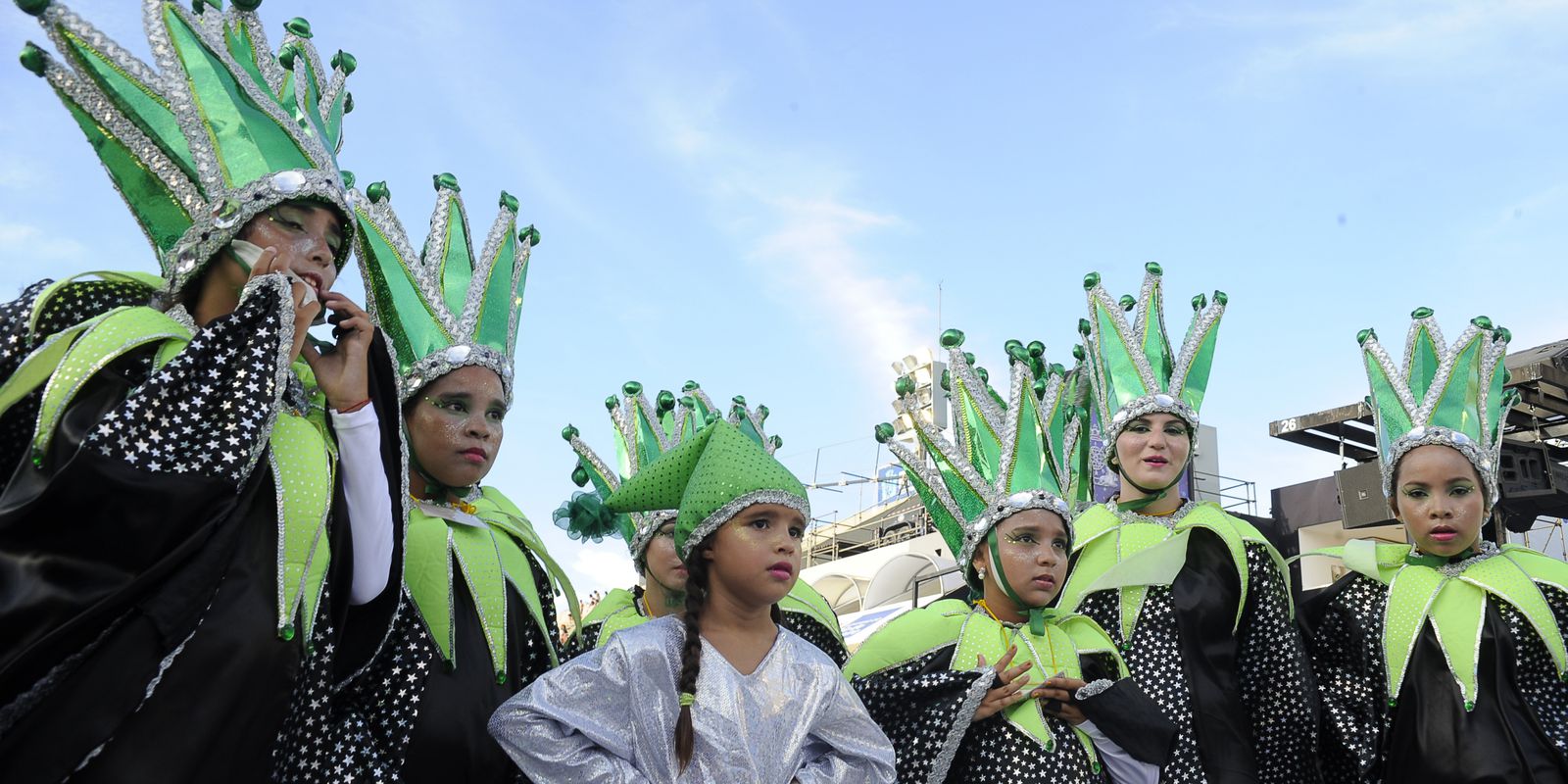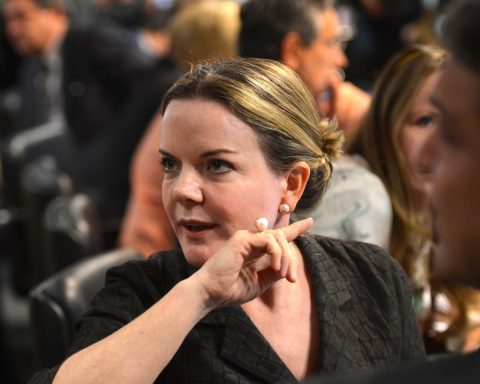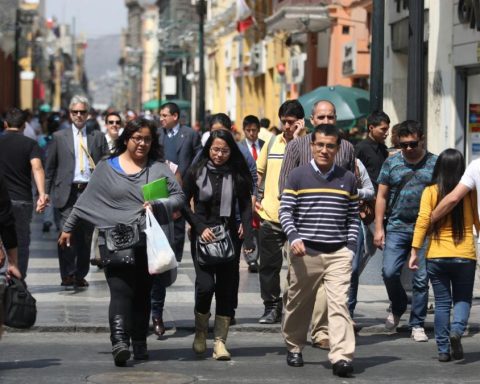The children’s samba schools end this Sunday (24) the off-season carnival parades at the Sambadrome in Rio de Janeiro, with gates open from 3 pm and free admission to the stands. The opening of the event is scheduled for 15:30, with the presentation of the Orquestra Popular Manoel Couto, formed by 73 musicians including children and young people, students from the public school system, who will play traditional sambas-enredo, classics of Brazilian popular music, in addition to the Rio de Janeiro anthem Wonderful city.
Spectators will also be able to enjoy the children’s carnival procession, made up of King Momo, the queen, princesses and the couple of master of ceremonies and flag bearer.
The press officer of the Associação das Escolas de Samba Mirins do Rio de Janeiro, Arleson Rezende, informed that, to enter Marquês de Sapucaí, it is necessary to present proof of vaccination against covid-19. According to the association’s director of Carnival and Operations, Alexandre Moraes, this has been a long-awaited moment for two years. “The children are euphoric, overjoyed at the possibility of playing Carnival on the Samba Passarela in health and safety.”
The first school to parade is the Still Existing Children of Vila Kennedy, with the plot Having a Birthday Is Celebrating Life, and Today Is My Party Day. The school comes with 16 wings and 600 components, in addition to 120 percussionists who are part of the drums.
Ciep’s United Hearts will be the second association to enter the Sambadrome, singing the plot Living and Learning to Play, which chronicles the history of games from the dawn of humanity to the modern olympics. The school’s front committee is made up of 12 members who will simulate a game of chess.
life and hope
The Empire of the Future will tell The Curumim Battle Against the Jurupari Monster. Authored by the carnival artist Raphael Ladeira, the plot highlights the importance of life, hope and fraternity to overcome the “monsters” that arise, like the pandemic of the new coronavirus. The school’s main colors are green, white, gold and silver.
Then comes Pimpolhos da Grande Rio, by Duque de Caxias, Baixada Fluminense, with the plot Look, Quitandinha de Erê is beautiful”. Thirty Bahian women and 60 dancers will help the association to tell spectators about the party offered to Erês, entities that, in the Yoruba language, can represent fun and games, in the candomblé barracks.
The fifth school to set foot on Passarela do Samba is Golfinhos do Rio de Janeiro. She brings the plot Dolphins Invade the Northeast. Founded on November 15, 2020, Golfinhos do Rio de Janeiro has yellow and blue on its flag and has Ana Gabriela Teixeira de Carvalho as the queen of the drums.
The blue and white colors of Herdeiros da Vila come next, with the plot You Semba Lá… That I Sambo Here! The Free Corner of Angola, by Rosa Magalhães and Alex Varela. The plot speaks of the tradition and resistance of the Angolan people who were brought to Brazil as slaves and here generated a strong mix of identities with Brazilians.
The Apprentices of Acadêmicos do Salgueiro arrive at the avenue soon after, bringing the plot river from there to here, by Roberto Szaniecki, which lets the carioca tell his own story. “And Salgueiro responds with a message of hope, even if he has to get away with it, like those from Rio de Janeiro.” The composers of the samba-enredo are Celso Trindade, Demá Chagas, Bala, Arizão, Guaracy and Quinzinho. the samba river from there to herefrom Salgueiro, marked an era on the avenue, in 1994.
Birthday
Then come the Filhos da Águia da Portela, with the plot It’s party!, what commemorates the 20th anniversary of the association’s foundation, through the parades already presented and which also, in a playful way, shows the importance of cultural, religious celebrations, dance and other manifestations that exist from North to South of Brazil, with all the richness and colorful.
Infantes do Lins will present the plot Our Values in Tales and Fables, why the school wants to tell a whole range of challenges aimed at the communities that embrace the association, whether internal or external to the neighborhood in which it is inserted, showing the benefits brought by moral and ethical values, for children, young people and adolescents, and highlighting the emergence of junior schools as recreational and sociocultural and not as samba-company schools. In junior schools, the bias is cultural, say the organizers.
Marlene Povão, Beats the Beautiful Heart of this New Generation is the plot of the Nova Geração da Estácio de Sá, which pays homage to the samba singer Marlene Povão, 82, who is an official communicator and reference for Estácio, known and recognized by the entire Morro de São Carlos community. Daughter of Iansã and Xangô, adoring children from land and space, Marlene Povão is considered a striking figure in samba.
Backyard
The eleventh child school to parade is Mangueira do Amanhã, with the theme Thank you from Fundo do Nosso Quintal. “Mangueira do Amanhã embarks with a hand chime, banjo, tambourine, tambourine and guitar on the Estação Primeira platform to the Olaria neighborhood to celebrate the 45th anniversary of Fundo de Quintal! On this short trip between the two backyards where not only tamarind and mango trees were born, but the biggest names in samba, alto party and pagode”, says the author of the plot, Bruno Faria. The trip is based on the melodies and lyrics that are part of the national culture “and, mainly, of the history of Brazilian popular music!”.
The Little Star of Youth brings as a plot The Feast of the Divine, which is held seven weeks after Easter Sunday, on the day of Pentecost, to commemorate the descent of the Holy Spirit on the 12 apostles. This traditional Brazilian folklore festival is a mixture of religious and profane manifestations, that is, without a sacred character. The plot narrates the origin of the Festa do Divino, in Portugal, in the 14th century, until the present day, remembering the celebrations throughout Brazil, especially those in Maranhão, Pirenópolis, in Goiás, and Paraty, in Rio de Janeiro. of January. the samba Feast of the Divine was interpreted by the Independent Youth of Padre Miguel, in the carnival of 1974.
Penultimate to parade at Marquês de Sapucaí, Petizes da Penha brings the plot Once upon a time… Once again… Once again, by Dy Fernandes. The strength of the forest and popular folklore will be sung by Petizes da Penha. The 80 members of the school’s drums come dressed as a sailor, representing the Marujada de Parintins, in Pará, which is the official band of Caprichoso, Boi-Bumbá that disputes the Folkloric Festival of Parintins, in Amazonas.
Closing the parades, Miúda da Cabuçu comes to tell The African Influence on the Carioca Carnival. Written by Paulo César Alves, the plot talks about the costumes of orixás, with their exuberant colors and the vestments that influenced the making of costumes for Bahian women and various wings of samba schools. The foods served at samba events such as feijoada and Bahian angu were not forgotten, in addition to African props, including whelks, beads, necklaces and various other materials.
















